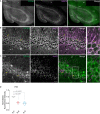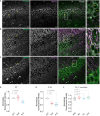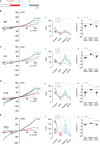TRPM4 Expression During Postnatal Developmental of Mouse CA1 Pyramidal Neurons
- PMID: 33994959
- PMCID: PMC8113704
- DOI: 10.3389/fnana.2021.643287
TRPM4 Expression During Postnatal Developmental of Mouse CA1 Pyramidal Neurons
Abstract
TRPM4 is a non-selective cation channel activated by intracellular calcium and permeable to monovalent cations. This channel participates in the control of neuronal firing, neuronal plasticity, and neuronal death. TRPM4 depolarizes dendritic spines and is critical for the induction of NMDA receptor-dependent long-term potentiation in CA1 pyramidal neurons. Despite its functional importance, no subcellular localization or expression during postnatal development has been described in this area. To examine the localization and expression of TRPM4, we performed duplex immunofluorescence and patch-clamp in brain slices at different postnatal ages in C57BL/6J mice. At P0 we found TRPM4 is expressed with a somatic pattern. At P7, P14, and P35, TRPM4 expression extended from the soma to the apical dendrites but was excluded from the axon initial segment. Patch-clamp recordings showed a TRPM4-like current active at the resting membrane potential from P0, which increased throughout the postnatal development. This current was dependent on intracellular Ca2+ (I CAN ) and sensitive to 9-phenanthrol (9-Ph). Inhibiting TRPM4 with 9-Ph hyperpolarized the membrane potential at P14 and P35, with no effect in earlier stages. Together, these results show that TRPM4 is expressed in CA1 pyramidal neurons in the soma and apical dendrites and associated with a TRPM4-like current, which depolarizes the neurons. The expression, localization, and function of TRPM4 throughout postnatal development in the CA1 hippocampal may underlie an important mechanism of control of membrane potential and action potential firing during critical periods of neuronal development, particularly during the establishment of circuits.
Keywords: CA1; ICAN; TRPM4; hippocampus; pyramidal neurons.
Copyright © 2021 Riquelme, Cerda and Leiva-Salcedo.
Conflict of interest statement
The authors declare that the research was conducted in the absence of any commercial or financial relationships that could be construed as a potential conflict of interest.
Figures




Similar articles
-
Subcellular Localization and Activity of TRPM4 in Medial Prefrontal Cortex Layer 2/3.Front Cell Neurosci. 2018 Jan 30;12:12. doi: 10.3389/fncel.2018.00012. eCollection 2018. Front Cell Neurosci. 2018. PMID: 29440991 Free PMC article.
-
Dendritic voltage-gated ion channels regulate the action potential firing mode of hippocampal CA1 pyramidal neurons.J Neurophysiol. 1999 Oct;82(4):1895-901. doi: 10.1152/jn.1999.82.4.1895. J Neurophysiol. 1999. PMID: 10515978
-
ICAN (TRPM4) Contributes to the Intrinsic Excitability of Prefrontal Cortex Layer 2/3 Pyramidal Neurons.Int J Mol Sci. 2021 May 17;22(10):5268. doi: 10.3390/ijms22105268. Int J Mol Sci. 2021. PMID: 34067824 Free PMC article.
-
TRPM4-dependent post-synaptic depolarization is essential for the induction of NMDA receptor-dependent LTP in CA1 hippocampal neurons.Pflugers Arch. 2016 Apr;468(4):593-607. doi: 10.1007/s00424-015-1764-7. Epub 2015 Dec 3. Pflugers Arch. 2016. PMID: 26631168 Free PMC article.
-
Pharmacological Modulation and (Patho)Physiological Roles of TRPM4 Channel-Part 1: Modulation of TRPM4.Pharmaceuticals (Basel). 2022 Jan 10;15(1):81. doi: 10.3390/ph15010081. Pharmaceuticals (Basel). 2022. PMID: 35056138 Free PMC article. Review.
Cited by
-
A glibenclamide-sensitive TRPM4-mediated component of CA1 excitatory postsynaptic potentials appears in experimental autoimmune encephalomyelitis.Sci Rep. 2022 Apr 9;12(1):6000. doi: 10.1038/s41598-022-09875-6. Sci Rep. 2022. PMID: 35397639 Free PMC article.
-
Pharmacological Modulation and (Patho)Physiological Roles of TRPM4 Channel-Part 2: TRPM4 in Health and Disease.Pharmaceuticals (Basel). 2021 Dec 28;15(1):40. doi: 10.3390/ph15010040. Pharmaceuticals (Basel). 2021. PMID: 35056097 Free PMC article. Review.
-
Ulinastatin modulates TRPM4 expression and apoptosis to mitigate cognitive dysfunction in aged perioperative neurocognitive disorder rats.Sci Rep. 2025 May 22;15(1):17774. doi: 10.1038/s41598-025-01394-4. Sci Rep. 2025. PMID: 40404680 Free PMC article.
-
Cholinergic modulation shifts the response of CA1 pyramidal cells to depolarizing ramps via TRPM4 channels with potential implications for place field firing.Elife. 2023 Jul 5;12:e84387. doi: 10.7554/eLife.84387. Elife. 2023. PMID: 37404129 Free PMC article.
-
The TRP channels serving as chemical-to-electrical signal converter.Physiol Rev. 2025 Jul 1;105(3):1033-1074. doi: 10.1152/physrev.00012.2024. Epub 2025 Jan 15. Physiol Rev. 2025. PMID: 39813402 Free PMC article. Review.
References
-
- Andersen P., Morris R., Amaral D., Bliss T., O’Keefe J. (2006). The Hippocampus Book. Illustrated Edition. Oxford: Oxford University Press.
-
- Bender R. A., Galindo R., Mameli M., Gonzalez-Vega R., Valenzuela C. F., Baram T. Z. (2005). Synchronized network activity in developing rat hippocampus involves regional hyperpolarization-activated cyclic nucleotide-gated (HCN) channel function. Eur. J. Neurosci. 22 2669–2674. 10.1111/j.1460-9568.2005.04407.x - DOI - PMC - PubMed
-
- Bovet-Carmona M., Krautwald K., Menigoz A., Vennekens R., Balschun D., Angenstein F. (2019). Low frequency pulse stimulation of Schaffer collaterals in Trpm4-/- knockout rats differently affects baseline BOLD signals in target regions of the right hippocampus but not BOLD responses at the site of stimulation. Neuroimage 188 347–356. 10.1016/j.neuroimage.2018.12.020 - DOI - PubMed
-
- Bovet-Carmona M., Menigoz A., Pinto S., Tambuyzer T., Krautwald K., Voets T., et al. (2018). Disentangling the role of TRPM4 in hippocampus-dependent plasticity and learning: an electrophysiological, behavioral and FMRI approach. Brain Struct. Funct. 223 3557–3576. 10.1007/s00429-018-1706-1 - DOI - PubMed
LinkOut - more resources
Full Text Sources
Other Literature Sources
Research Materials
Miscellaneous

